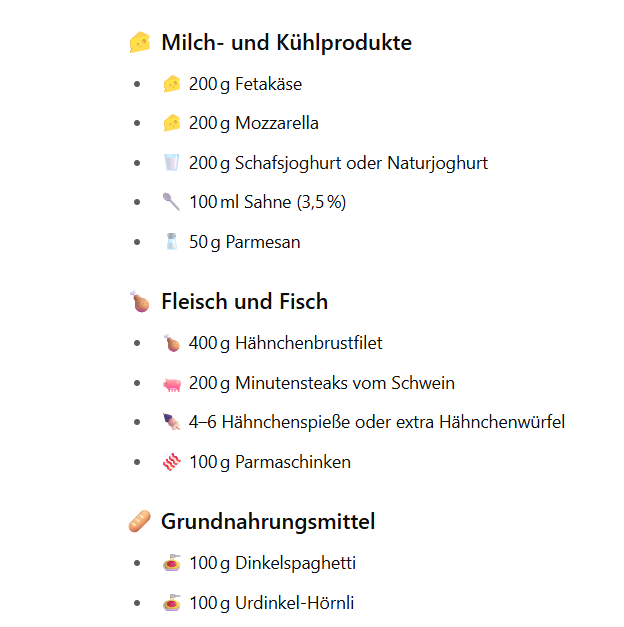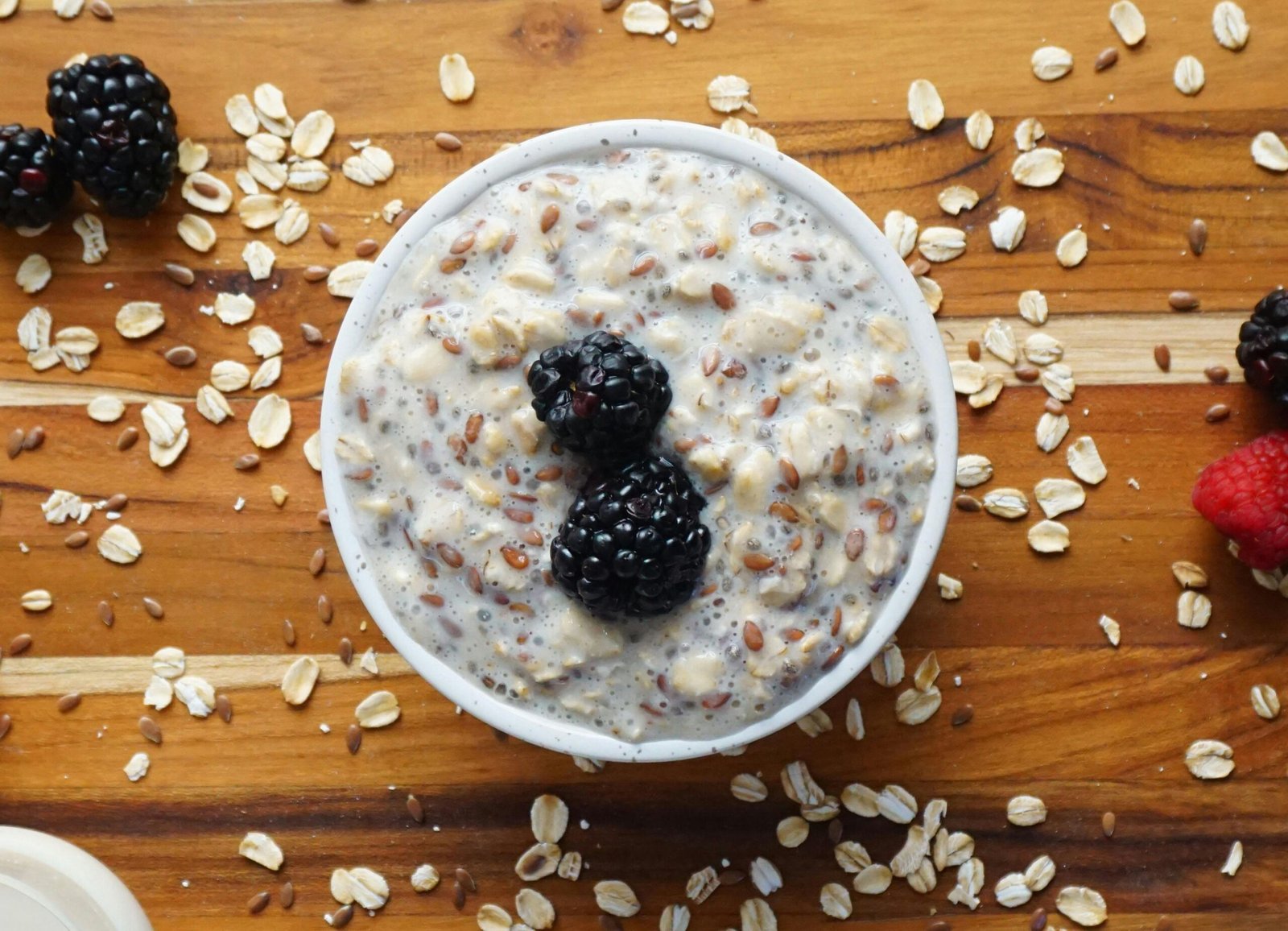🛒 Shopping Lists – this Way You Effectively save Time and Money
Shopping without a structured list often leads to the same foods and ingredients regularly ending up in the shopping cart, quickly resulting in monotony in daily kitchen life. Furthermore, there’s often not enough time to consistently implement new, varied meal ideas. At the same time, it’s easy to forget important ingredients – for example, due to distractions in the supermarket, spontaneous offers, or time pressure. Such unplanned situations not only cause additional effort and extra trips to the store but occasionally also unexpectedly increase expenses.
The solution is both simple and effective: an optimally prepared shopping list!
Why Shopping Lists are an Absolute Must
A well-structured shopping list not only helps you remember all important ingredients but also saves time, money, and unnecessary trips. By shopping purposefully, impulse purchases can be significantly reduced.
Classic Situations when Shopping WITHOUT a Shopping List:
- Impulse Buys: Food items or promotional products end up in the shopping cart, even though they are not truly needed or don’t match existing ingredients – often triggered by supermarket advertising.
- Duplicate Purchases: Products are unconsciously bought multiple times because no prior inventory check of supplies at home was done, leading to uncertainty about whether the product is still available.
- Forgotten Staple Ingredients: Ingredients for already planned meals are accidentally not bought, causing additional time and repeat trips to the store. Or you think you still have the ingredients at home, but then realize you don’t, and have to go to the supermarket again.
- Less Varied Diet: Without planning, the same foods often end up in the shopping cart. This leads to monotony in meals, often the same recipes, and too little variety in the consumed nutrients.
- Convenience Foods: Due to lack of time, ready-made products or convenience food are spontaneously bought, which is not an optimal long-term solution and can additionally strain the budget.
- Exceeding the Planned Budget: Without a shopping list and prior weekly planning, food expenses often increase unnoticed, or at the checkout, you realize how expensive everything has become, and at home, you feel like you haven’t really bought anything substantial for the money spent.
The Ideal Shopping List
Small Step-by-Step Guide
Step 1: Optimally Combine Meal Planning and Inventory Taking
- A well-structured shopping list begins with clear weekly planning of the meals. It should take into account which foods are still available from the previous week or need to be consumed soon. A regular pantry check (refrigerator, freezer, pantry) prevents unnecessary duplicate purchases and ensures that expiring foods are used in time.
- An additional advantage of this method: Regular inventory checks ensure that a basic stock of non-perishable foods is always available at home. This is particularly important to reliably provide for the family for several days in case of unforeseen situations such as illness, pandemics, or other emergencies.
Step 2: Deliberately Check Offers and Promotions Before Meal Planning and Consider Your Budget
It’s worthwhile to check your supermarket’s current offers and promotions even before creating your weekly plan. This way, you can directly consider during meal planning which ingredients are currently particularly inexpensive or seasonally available. This not only allows for financial savings but also promotes a varied diet.
At the same time, you should plan your available budget in this step: If less money is available in a week, you can specifically decide which meals need to be planned more cost-effectively. For example, with fewer meat dishes or seasonal vegetables, you can often save a lot of money without having to compromise on a healthy diet.
However, it is important to choose carefully: Not every seemingly attractive offer is actually sensible, healthy, or suitable for the planned meals. A conscious approach to special offers prevents unnecessary or unsuitable products from being bought, which then remain unused or strain the planned budget.
Step 3: Use Categories on Your Shopping List
Divide your shopping list into categories such as:
- 🥦 Vegetables & Fruits
- 🧀 Dairy & Eggs
- 🍗 Meat, Fish, Tofu
- 🥖 Staples (Rice, Pasta, Flour)
- 🧊 Frozen Products
- 🥤 Beverages
- 🧽 Miscellaneous (e.g., Household Items)
This way you save valuable time in the supermarket and avoid unnecessary trips.
👉 Here’s a Practical Shopping List by Categories plus Budget Section PDF
Step 5: Plan for Household Items Right Away and Save Smartly
Consistently use the shopping list for household items as well. Regularly check if items like laundry detergent, toilet paper, paper towels, or cleaning supplies are running out. It is advisable to purchase such items collectively once a month to avoid additional trips and save money in the long run.
Additional Tip: For household items too, it’s worth taking a targeted look at current offers and promotions. Larger packaging units or special offers are often significantly cheaper. If enough storage space is available, it makes sense to buy such products in bulk – this can further relieve the household budget.
Step 6: Record and Plan Cosmetic Items Separately
It is advisable to record cosmetic items separately from household items on the shopping list. The reason: These items are often individually selected, regularly bought in special stores or online shops, and can meet specific requirements (e.g., hair care, facial care, creams, decorative cosmetics).
Especially when shopping is done by different people, a clear separation can be helpful. Not everyone is familiar with the individual product preferences of others, which is particularly true for cosmetics. Through separate and monthly planning of the required cosmetic items, you can also gain an overview of actual consumption and shop more purposefully.
Additional Tip: For cosmetic products, too, pay attention to promotional prices and offers. Larger quantities or special discount promotions are particularly suitable for saving money in the long run – provided there is sufficient storage space.
Step 7: Digital or Classic Shopping List?
Both variants have advantages:
- 📄 Paper
Ideal for directly noting down items that run out during the week. It’s important that the note is always in the same place (e.g., in the kitchen). This way, all family members, regardless of age, can quickly add something without having to search for a long time – especially practical when daily life is busy.
- 📱 Apps
Reusable lists, quick adjustments, easy sharing with other family members, automatic sorting by categories.
Additional Practical Tip:
Never go grocery shopping hungry!
Hunger often tempts you to spontaneously buy foods you’re craving or to rush through shopping to eat something quickly. It’s particularly helpful to also keep in mind individual phases or special situations where you might have increased cravings for certain foods – for example, during your cycle or pregnancy. This helps to make more conscious and targeted shopping decisions.
Shopping list and shopping bags always at hand!
Remember to take your shopping list with you, especially if you prefer a classic paper form. It’s also worthwhile to reuse shopping bags from your last trip. This saves money, avoids unnecessary waste, and prevents an excessive accumulation of shopping bags at home. Therefore, it’s best to always place your shopping bags and shopping list in a fixed spot so they are readily available for your next shopping trip.
🚀 your Solution: K.B. Kitchen Assistant Kati
With Kati, you create your shopping list in seconds
- ✅ Automatic shopping list based on your weekly plan
- ✅ Structured categories for efficient shopping
- ✅ Also considers household and cosmetic items
This way you have more time for what’s truly important to you – Kati does the thinking for you!
👉 Explore the full potential of “Kati”!


